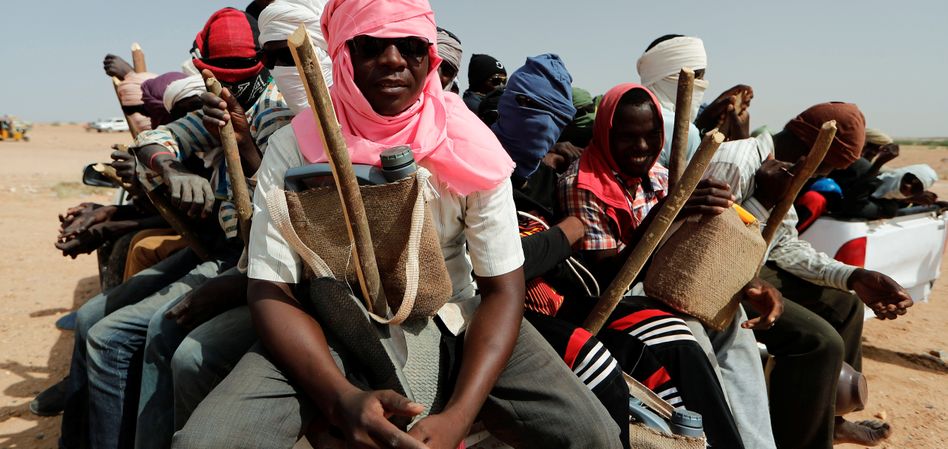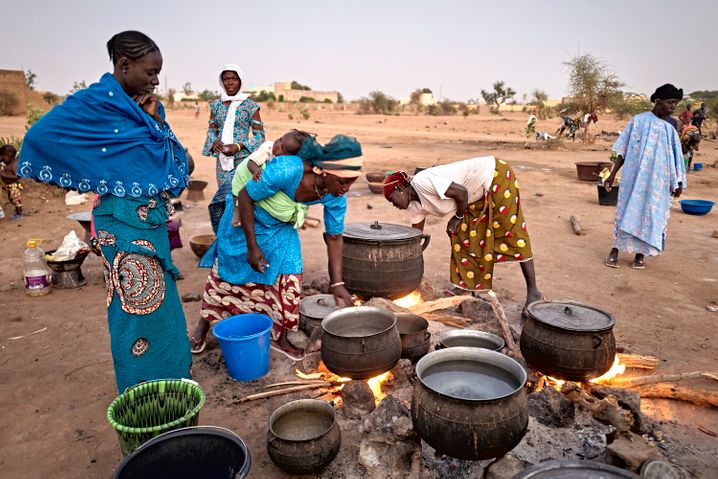www.aljazeerah.info
News, September 2020
Archives
Mission & Name
Conflict Terminology
Editorials
Gaza Holocaust
Gulf War
Isdood
Islam
News
News Photos
Opinion Editorials
US Foreign Policy (Dr. El-Najjar's Articles)
www.aljazeerah.info
|
Editorial Note: The following news reports are summaries from original sources. They may also include corrections of Arabic names and political terminology. Comments are in parentheses. |
Coronavirus Pandemic Could Trigger a Million People to Leave their Homes in the African Sahel Region North to Libya and Europe
Der Spiegel, September 28, 2020
 |
 |
| Sub-Saharan Africans preparing to move north to Libya, file, September 27, 2020 | Displaced women in Mali preparing food, file, September 23, 2020 |
Predicting Refugee Movements? There's an App for That
According to an algorithm, the coronavirus pandemic could trigger a million people to leave their homes in the Sahel region. Such forecasts could help humanitarian organizations recognize developments before they happen and react more quickly.
For our Global Societies project, reporters around the world will be writing about societal problems, sustainability and development in Asia, Africa, Latin America and Europe. The series will include features, analyses, photo essays, videos and podcasts looking behind the curtain of globalization. The project is generously funded by the Bill & Melinda Gates Foundation.
A task that might take an expert hours to complete can be handled in mere seconds by Foresight. The forecasting software from the Danish Refugee Council (DRC) analyzes data from more than 120 sources, examines patterns and then calculates, for example, how the corona crisis might affect refugee flows.
The data showed, for example, that the pandemic could cause around a million people in countries including Burkina Faso, Niger, Mali and Nigeria to feel they have no other choice but to leave their homes. According to the forecast, in other words, suffering will increase in the region, one which is already facing numerous conflicts.
Software like Foresight is intended to make the decision-making process more efficient when it comes to supplying humanitarian aid and launching the missions that go along with it. "The tool helps us predict more quickly what will happen so that we can plan better and intervene earlier in a humanitarian crisis," says Charlotte Slente, general secretary of the DRC. Rapid intervention, she adds, often saves money in the long run.
Experts from refugee aid organizations have made previous attempts to improve their forecasting ability on the basis of data and pattern recognition. The algorithm used by the Foresight app is now supposed to forecast even more precisely when a situation will develop and better analyze the effects of different variables like the economic situation, the presence of conflict, the climate and political leadership. Slente refers to such variables as "the DNA of displacement."
Not a Silver Bullet
The algorithm, of course, is not a silver bullet. "The software doesn't know what will happen tomorrow or next week," Slente concedes. "The forecasts focus on the next one to three years. The model also can't predict whether people will become internally displaced or if they will cross international borders."
The Danish Refugee Council intends to make the forecasting software available to other aid organizations in the future. And the interest in such tools within the humanitarian community is considerable, even if the use of data analysis and forecasting software is still in the experimental phase.
The fact that it has taken so long for such data analysis tools to make a mark in development aid and crisis response is largely the result of a lack of technical expertise in the sector, along with the limited resources available to humanitarian organizations, believes data expert Miguel Luengo Oroz. "Humanitarian and data experts do not speak the same language; they do not share a common vocabulary or context, and often cannot align their goals," wrote Luengo Oroz, the chief data scientist for UN Global Pulse, in a 2017 essay.
UN Global Pulse is a United Nations initiative doing pioneering work at the nexus between development aid and technology. It is conducting research into the potential of Big Data and artificial intelligence in addition to supporting other UN agencies in the implementation of projects. In response to the pandemic, governments around the world have grown increasingly interested in data-focused models that might be able to forecast the spread of COVID-19 infections and the effectiveness of planned strategies along with their possible side effects.
The innovation team at the UN Refugee Agency (UNHCR) has already developed a number of experimental approaches to gather clues about possible future migration events. Data analysts, for example, have used open source weather data and Facebook postings from migrant traffickers for clues about smuggling prices, the most frequently used routes and assembly points. They have also searched Twitter using an algorithm to find key words and negative expressions to determine the broader mood, a practice known as "sentiment analysis."
The Price of Goats
Sometimes, unexpected metrics like rising prices for water cannisters and dropping prices for goats can hint at an upcoming exodus - such as in Somalia. "When people started getting rid of 50, 60 goats at once, prices were pushed down and we had an indication that people were planning to flee," Andrew Harper of the UNHCR said at a 2019 re: publica conference.
The reasons for flight and displacement, though, are myriad, which makes the development of forecasting software a challenge. "It is a complex interaction of many different factors, and you can't explain the phenomenon if you only concentrate on a single aspect," says Alexander Kjærum, who is the tech expert for the Danish Refugee Council and was part of the Foresight development team. He says he was surprised to see how important factors beyond conflict were for displacement -- things like government leadership and human rights violations.
When the pilot project was launched two-and-a-half years ago, it wasn't clear if the app would be able to achieve meaningful results. The development process, says Kjærum, was a constant process of trial and error. Today, though, Kjærum is optimistic: "We are still in the development phase and are constantly working on refining and improving the software, but results thus far have been encouraging and demonstrate a high degree of precision," he says.
To test Foresight, the team fed the software with data pertaining to Myanmar and Afghanistan and had it simulate scenarios for time periods in the past. The forecasts generated by the app were then compared with what actually happened. According to Kjærum, the algorithm came up with rather precise forecasts, with an error range of 8 to 10 percent.
In coming up with its forecasts, the self-learning algorithm analyzes historical data from the last 20 to 25 years to identify patterns and use them to draw conclusions for the future: The more complete datasets from the past are available, the more precise the forecasts. The software primarily accesses national data, from organizations like the UN, the World Bank and the respective governments and it prioritizes data pertaining to conflicts, human rights abuses, economic developments and socio-economic factors. The disadvantage to this approach is that focusing on national instead of local data means that it is more difficult to analyze locally confined conflicts.
Correlations Between Different Indicators
Fifteen key indicators are particularly relevant for the app to calculate the risk of forced displacement, including factors such as unemployment, corruption, the availability of public services, food security, the frequency of politically motivated murder, the number of civilian conflict victims, human rights violations, natural disasters and social inequality. The software doesn’t just calculate the number of displacements, users can also dive deeper into correlations between different indicators in a causality model.
The algorithm is also able to simulate different scenarios. If experts want to assess effects of the corona crisis, for example, they can model what would happen if the economy in a particular country was to plunge by a few percentage points, the government was to lose support or the intensity of conflict was to rise. Once each variable is adjusted, the software calculates a new risk assessment regarding forced displacements.
"But it is difficult for the software to predict sudden or unprecedented events, such as the Rohingya conflict in 2017 and the mass displacement," Kjærum allows. In that conflict, Myanmar soldiers murdered thousands of people in a brutal military offensive, destroyed villages and raped women and children belonging to the Muslim minority. More than 700,000 people were forced to flee.
In the coming months, more country simulations will be made available. In the future, the app code is to be made available online for other users to enable organizations to adjust it for their own needs and to expand it with additional data.
"Forecasting is not an exact science and should not be the only factor in decision making."
Charlotte Slente, general secretary of the Danish Refugee Council
The software's limitations, though, are also clear to Charlotte Slente, the DRC general secretary. "Forecasting is not an exact science and should not be the only factor in decision-making," she says. The experience and analyses of crisis workers and development experts, in other words, are not going to be replaced by an algorithm.
***
Share the link of this article with your facebook friendsFair Use Notice
This site contains copyrighted material the
use of which has not always been specifically authorized by the copyright
owner. We are making such material available in our efforts to advance
understanding of environmental, political, human rights, economic,
democracy, scientific, and social justice issues, etc. We believe this
constitutes a 'fair use' of any such copyrighted material as provided for
in section 107 of the US Copyright Law. In accordance with Title 17 U.S.C.
Section 107, the material on this site is
distributed without profit to those
who have expressed a prior interest in receiving the included information
for research and educational purposes. For more information go to: http://www.law.cornell.edu/uscode/17/107.shtml.
If you wish to use copyrighted material from this site for purposes of
your own that go beyond 'fair use', you must obtain permission from the
copyright owner.
|
|
|
|
||
|
||||||


